Hot Rolled Steel I Beams
- Loading Port:
- Tianjin Port, China
- Payment Terms:
- TT or LC
- Min Order Qty:
- 25MT m.t.
- Supply Capability:
- 10000MT m.t./month
OKorder Service Pledge
OKorder Financial Service
You Might Also Like
Specifications of Hot Rolled Steel I Beam
Standard: ASTM A36, EN10025, JIS, GB, etc.
Grade:S275, S355, SS400, Q235B, A36, etc
Sizes: 80MM-270MM
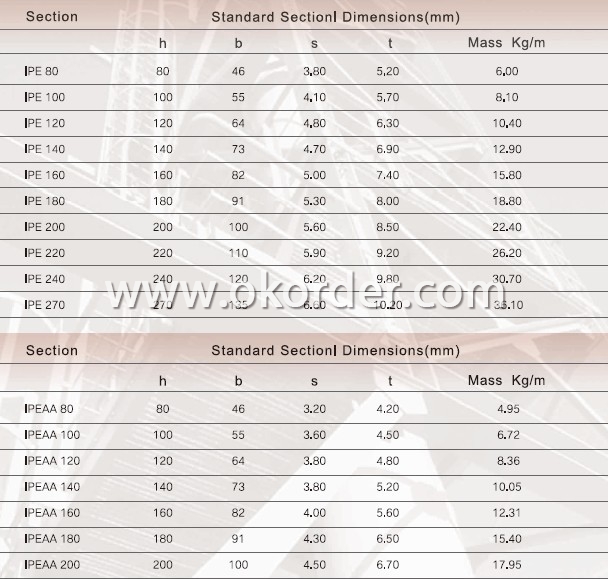
Applications of Hot Rolled Steel I Beam
Hot Rolled Steel I Beam is widely used in various building structures and engineering structures such as roof beams, bridges, transmission towers, hoisting machinery and transport machinery, ships, industrial furnaces, reaction tower, container frame and warehouse etc.
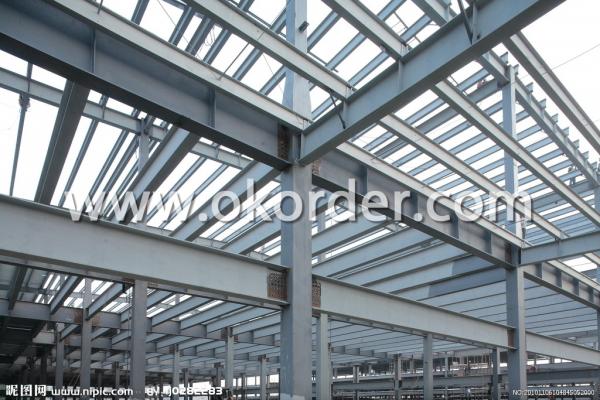
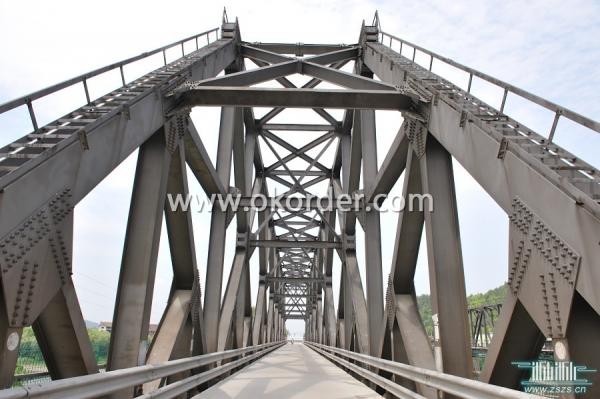
Package & Delivery Terms of Hot Rolled Steel I Beam
1. Package: All the hot rolled steel I beam will be tired by wire rod in bundles
2. Bundle weight: not more than 3.5MT for bulk vessel; less than 3 MT for container load
3. Marks:
Color marking: There will be color marking on both end of the bundle for the cargo delivered by bulk vessel. That makes it easily to distinguish at the destination port.
Tag mark: there will be tag mark tied up on the bundles. The information usually including supplier logo and name, product name, made in China, shipping marks and other information request by the customer.
If loading by container the marking is not needed, but we will prepare it as customer request.
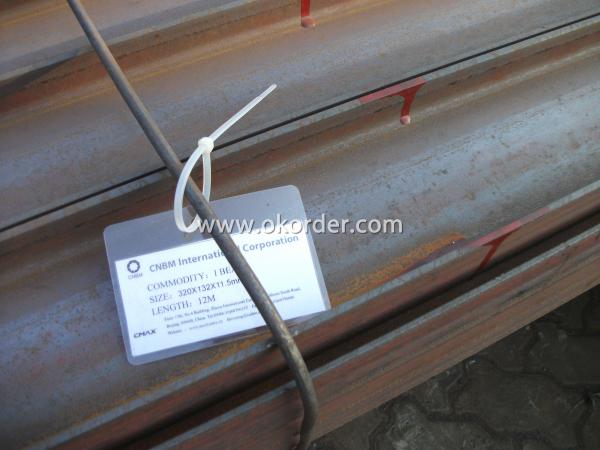
4. Transportation: the goods are delivered by truck from mill to loading port, the maximum quantity can be loaded is around 40MTs by each truck. If the order quantity cannot reach the full truck loaded, the transportation cost per ton will be little higher than full load.
5. Shipment: In containers or in bulk cargo

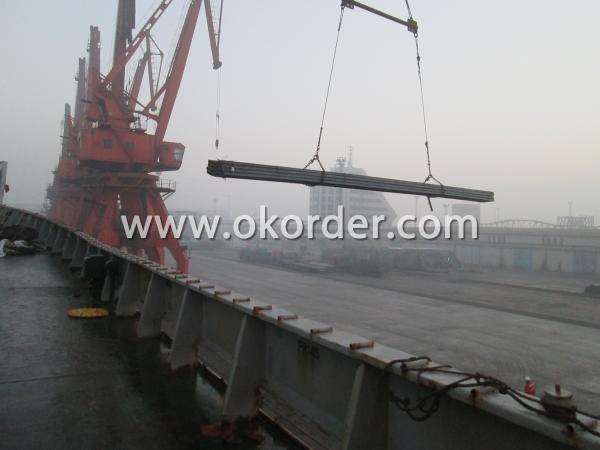
6. Delivery time: All the hot rolled steel I Beam will be at the port of the shipment within 45 days after receiving the L/C at sight ot the advance pyment by T/T
7. Payment: L/C at sight; 30% advance payment before production, 70% before shipment by T/T, etc.
Production flow of Hot Rolled Steel I Beam
Material prepare (billet) —heat up—rough rolling—precision rolling—cooling—packing—storage and transportation
- Q:How do you determine the appropriate size and shape of a steel I-beam for a specific application?
- To determine the appropriate size and shape of a steel I-beam for a specific application, several factors need to be considered. These include the load that the beam will be supporting, the span or distance between supports, and the structural requirements such as deflection limits and safety factors. Additionally, engineers often refer to structural design codes and guidelines, which provide standardized formulas and tables for selecting the appropriate beam size based on these factors. By analyzing the specific application requirements and consulting relevant resources, engineers can determine the most suitable size and shape of a steel I-beam.
- Q:Can steel I-beams be used in religious or worship buildings?
- Yes, steel I-beams can be used in religious or worship buildings. Steel I-beams are commonly used in construction due to their strength, durability, and versatility. They provide structural support and can be used to create large, open spaces without the need for excessive columns or load-bearing walls. This makes them ideal for religious or worship buildings, where a spacious and unobstructed interior is often desired to accommodate large congregations. Additionally, steel I-beams can be used to create intricate and aesthetically pleasing architectural designs, allowing for the creation of unique and visually stunning religious structures.
- Q:What are the common applications of steel I-beams in construction?
- Due to their strength, versatility, and durability, steel I-beams are extensively utilized in construction. They serve as vital elements in diverse structural systems, including buildings, bridges, and industrial facilities. The applications of steel I-beams in construction are numerous: 1. Building frames: Steel I-beams are commonly employed as primary load-bearing components in building frames. These beams provide exceptional support and stability, enabling the construction of spacious and open areas. Commercial buildings, warehouses, and residential structures often rely on I-beams to create their frameworks. 2. Bridges: The high strength-to-weight ratio of steel I-beams makes them ideal for bridge construction. They can span long distances, making them suitable for spanning rivers, valleys, and highways. I-beams form the backbone of bridge decks, effectively supporting the weight of vehicles and pedestrians. 3. Mezzanines: Construction of mezzanine floors, which act as intermediate floors between main floors, often involves steel I-beams. Mezzanines are commonly found in warehouses, factories, and retail spaces, offering additional storage or workspace. I-beams provide the necessary load-bearing capacity for these elevated platforms. 4. Industrial structures: Industrial structures, such as manufacturing plants, refineries, and power plants, heavily rely on steel I-beams. These beams can endure substantial loads and harsh environmental conditions, making them suitable for supporting heavy machinery, equipment, and storage systems. 5. Roof support: Steel I-beams are employed to support the roofs of large structures, such as stadiums, arenas, and exhibition halls. They ensure structural integrity and can withstand the weight of the roof materials, as well as any additional loads, like snow or wind. 6. Cantilevered structures: Cantilevered structures, which extend horizontally without additional support at one end, often incorporate steel I-beams. Balconies, canopies, and awnings are prominent examples. I-beams provide the necessary strength and stability to support these extended sections. In summary, steel I-beams are indispensable components in construction due to their strength and versatility. They find wide-ranging applications, from building frames and bridges to mezzanines and industrial structures. The use of steel I-beams is essential in ensuring the structural integrity and durability of various construction projects.
- Q:What are the considerations for corrosion protection of steel I-beams in marine environments?
- There are several key factors to keep in mind when it comes to protecting steel I-beams from corrosion in marine environments. These factors are crucial to ensure the beams' longevity and structural integrity since exposure to saltwater and other corrosive elements can greatly accelerate the corrosion process. 1. Material Selection: It is essential to choose the right type of steel for corrosion protection in marine environments. Stainless steel and galvanized steel are commonly used due to their natural resistance to corrosion. Stainless steel contains chromium, which forms a passive protective layer on the surface, preventing the underlying metal from corroding. Galvanized steel is coated with a layer of zinc, which acts as a sacrificial barrier, protecting the steel beneath it from corrosion. 2. Coatings and Paints: The application of coatings or paints specifically designed for marine environments is another effective method of protecting steel I-beams from corrosion. Epoxy coatings, polyurethane paints, or marine-grade coatings can create an additional barrier against saltwater and moisture, preventing direct contact with the steel surface and reducing the risk of corrosion. 3. Cathodic Protection: The implementation of cathodic protection systems can be advantageous for steel I-beams in marine environments. Cathodic protection involves using sacrificial anodes or impressed current systems to provide a protective current that counteracts the natural corrosion process. Sacrificial anodes, typically made of zinc or aluminum, are attached to the steel beams and corrode instead of the beams themselves, sacrificing themselves to protect the underlying steel. 4. Maintenance and Inspection: Regular inspection and maintenance play a critical role in ensuring ongoing corrosion protection for steel I-beams in marine environments. Inspections should be conducted to identify any signs of corrosion, coating damage, or other issues that may compromise the beams' integrity. Prompt repairs or recoating should be carried out as necessary to prevent further corrosion. 5. Design Considerations: Proper design can also contribute to corrosion protection in marine environments. For example, avoiding water traps or ensuring proper drainage can prevent moisture accumulation, which can accelerate corrosion. Additionally, selecting appropriate coatings or materials for connections and fasteners is essential to ensure the entire structure is adequately protected from corrosion. All in all, the considerations for corrosion protection of steel I-beams in marine environments involve choosing suitable materials, applying protective coatings or paints, implementing cathodic protection systems, conducting regular maintenance and inspections, and incorporating corrosion-resistant design features. By addressing these considerations, the risk of corrosion and subsequent structural damage can be minimized, ensuring the longevity and reliability of the steel I-beams.
- Q:Can steel I-beams be used in retail or shopping center construction?
- Yes, steel I-beams can be used in retail or shopping center construction. They are commonly used in commercial construction due to their strength, durability, and ability to support heavy loads. Steel I-beams provide structural stability, allowing for large open spaces and flexible floor layouts, which are often desired in retail or shopping center designs.
- Q:How do steel I-beams perform in terms of noise insulation?
- Steel I-beams typically do not provide significant noise insulation due to their rigid and dense nature. They are more commonly utilized for their load-bearing capabilities and structural strength rather than their ability to reduce noise transmission. To effectively reduce noise, additional insulation materials or alternative construction techniques should be considered.
- Q:Can steel I-beams be used in high-humidity environments?
- Yes, steel I-beams can be used in high-humidity environments. Steel is known for its durability and resistance to corrosion, which makes it suitable for various conditions, including high humidity. However, it is important to ensure proper maintenance and protection of the steel beams to prevent any potential corrosion or rusting in a high-humidity environment. Applying a protective coating or using stainless steel I-beams are some ways to enhance their resistance to humidity and prevent any potential damage. Regular inspections and maintenance should also be conducted to identify and address any signs of corrosion or degradation.
- Q:Does the 22# B I-beam length not need to overlap, local patches can find what standard?
- The waist reinforcement rib and anti twisting waist reinforcement structure of two kinds, two kinds of binding position in the beam on both sides (called waist muscle is definitely in the waist) beam waist rib plate is removed with plate thickness, according to the height of your waist reinforcement and stirrup number uniform layout. The waist ribs without plates are evenly arranged on both sides of the beam stirrups according to the height of the stirrups and the number of the ribs. The waist structural reinforcement of the anchor lap and 15d, anti twisting reinforcement anchorage and lap mode and a kind of beam.
- Q:Can steel I-beams be used in sports arenas or stadiums?
- Yes, steel I-beams can be used in sports arenas or stadiums. In fact, they are commonly used in the construction of these large structures due to their strength, durability, and versatility. Steel I-beams provide excellent load-bearing capabilities, allowing them to support heavy loads and withstand the forces generated during sporting events, such as vibrations, impacts, and dynamic loads. The use of steel I-beams in sports arenas and stadiums ensures the structural integrity of the facility, providing a safe environment for spectators and athletes. Additionally, the versatility of steel I-beams allows for flexible design options and efficient construction, making them a popular choice in the industry.
- Q:Can steel I-beams be used for architectural facades?
- Yes, steel I-beams can certainly be used for architectural facades. Steel I-beams offer several advantages that make them a popular choice for this application. Firstly, steel I-beams are known for their strength and durability. They can withstand heavy loads and provide structural support, making them suitable for large-scale architectural projects. Additionally, steel I-beams are resistant to weathering and corrosion, ensuring their longevity and reducing maintenance requirements. Furthermore, steel I-beams offer design flexibility. They can be fabricated in various sizes and shapes, allowing architects to create unique and visually appealing facades. The sleek and modern look of steel I-beams can add an industrial or contemporary aesthetic to a building's exterior. In terms of installation, steel I-beams are relatively easy to work with. They can be prefabricated off-site, saving time and reducing construction costs. The lightweight nature of the steel also simplifies the installation process. Lastly, steel is a sustainable material choice. It is highly recyclable, reducing the environmental impact of construction projects. Moreover, steel I-beams can be designed to maximize energy efficiency, incorporating insulation and other features to improve a building's overall performance. Overall, steel I-beams offer numerous advantages for architectural facades, including strength, durability, design flexibility, ease of installation, and sustainability. Architects and designers can leverage these benefits to create visually striking and functional building exteriors.
1. Manufacturer Overview |
|
|---|---|
| Location | Qinhuangdao, China |
| Year Established | 2000 |
| Annual Output Value | Above US$ 300 Million |
| Main Markets | Mid East; Africa; Southeast Asia; Brazil |
| Company Certifications | ISO 9001:2008; |
2. Manufacturer Certificates |
|
|---|---|
| a) Certification Name | |
| Range | |
| Reference | |
| Validity Period | |
3. Manufacturer Capability |
|
|---|---|
| a)Trade Capacity | |
| Nearest Port | Tianjin; |
| Export Percentage | 70% - 80% |
| No.of Employees in Trade Department | 21-50 People |
| Language Spoken: | English; Chinese; |
| b)Factory Information | |
| Factory Size: | Above 400,000 square meters |
| No. of Production Lines | 2 |
| Contract Manufacturing | OEM Service Offered; |
| Product Price Range | Average |
Send your message to us
Hot Rolled Steel I Beams
- Loading Port:
- Tianjin Port, China
- Payment Terms:
- TT or LC
- Min Order Qty:
- 25MT m.t.
- Supply Capability:
- 10000MT m.t./month
OKorder Service Pledge
OKorder Financial Service
Similar products
New products
Hot products
Related keywords


























